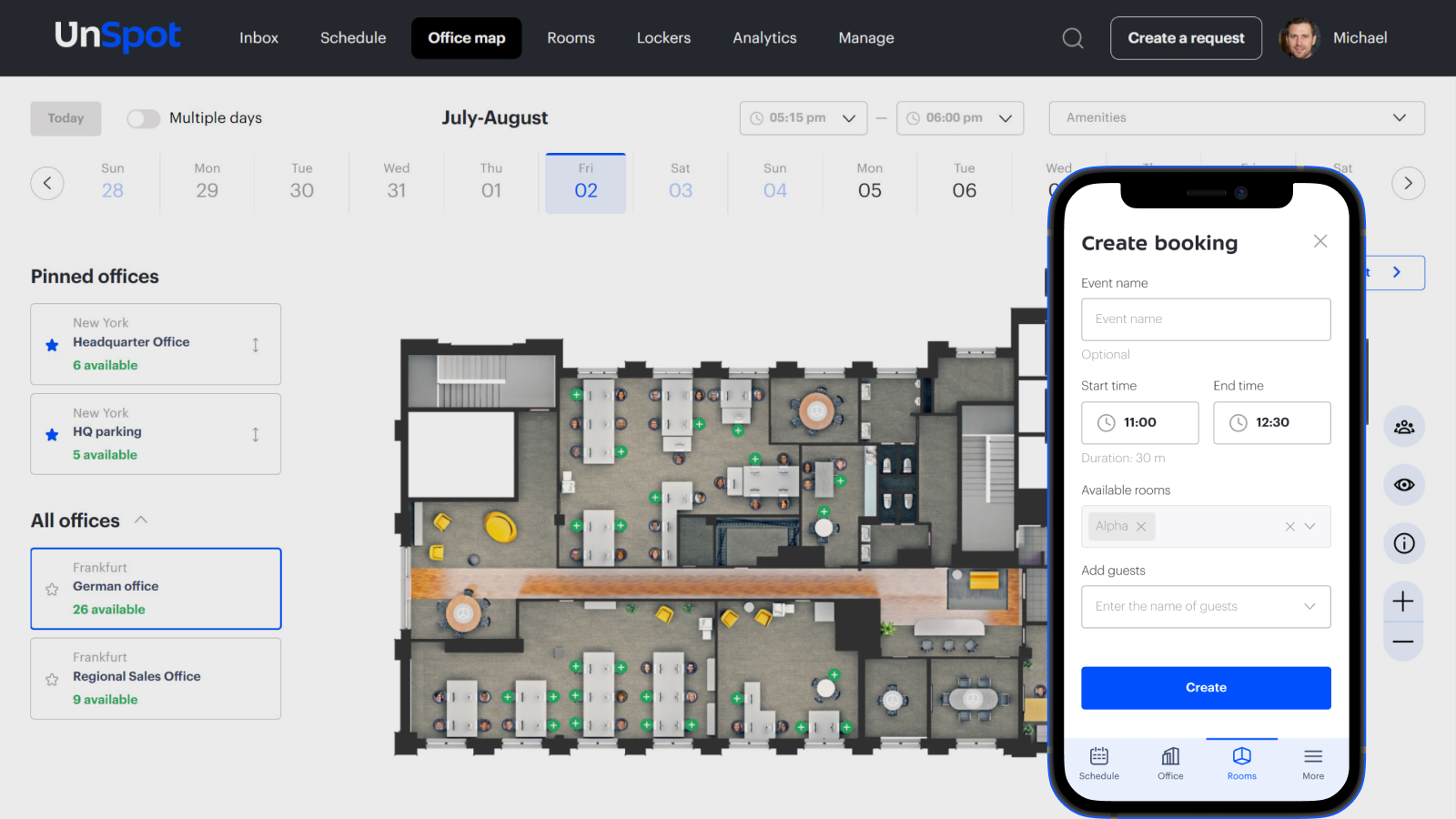In this article, we'll explore everything you need to know about workplace management strategies and the role of modern technologies in this process, providing a complete workplace management guide ⬇️
What Is Workplace Management?
A workplace management definition is the process of organizing an office or workplace environment to effectively support employees’ tasks, optimize company resources, and cultivate a comfortable work atmosphere. It goes beyond furniture and layout — encompassing the use of technology, strategic resource allocation, and the design of spaces that promote productivity through well-structured workplace management processes.
Goals of Workplace Management:
- Maximize the use of meeting rooms
- Ensure all workstations are occupied
- Keep equipment operational
- Provide a comfortable working environment
- Ensure easy access to tools and resources
⭐ Efficient workplace resource management isn’t just about comfort — it’s about reducing costs and boosting workplace productivity. When everything works seamlessly and employees don’t waste time looking for resources, they have all the tools they need to focus fully on their tasks. Rational use of resources also minimizes expenses on repairs and supplies, benefiting both employees and the business.
Benefits of Workplace Management
- Enhanced Productivity: A well-structured workspace, supported by efficient processes and clear protocols, is key to a well-managed workplace and helps employees focus on their core tasks without unnecessary distractions.
- Optimized Resource Utilization: By analyzing space usage and equipment needs, companies can allocate resources more intelligently and streamline daily operations, reducing costs and avoiding waste.
- Improved Collaboration: Properly managed offices promote better interaction among team members, facilitating both formal meetings and casual brainstorming sessions.
- Higher Employee Satisfaction: When employees feel comfortable and supported in their work environment, overall morale and job satisfaction tend to rise.
- Scalability and Adaptability: Effective workplace management strategies demonstrate how workplace management enables organizations to respond quickly to growth, restructuring, or shifting market demands by making space adjustments with minimal disruption.
The Five Core Elements of Office Management
1. Facility Management
Property management ensures that office systems run smoothly and safely, creating an environment that promotes employee productivity.
Safety: How technology keeps the office secure. Office security starts with access control systems. Tools like keycards or mobile passes can restrict entry to unauthorized individuals. For example, electronic passes can be deactivated instantly if lost.
According to BryteSoft, Microsoft is using the Internet of Things (IoT) to monitor various aspects of the workplace environment, including controlling access to restricted areas, lighting control and climate control.
Operational systems: The invisible foundation of productivity. Ensuring that the workplace runs smoothly and efficiently hinges on “invisible” systems like HVAC, lighting, and fire safety. It's important to maintain them regularly to keep work running smoothly and to avoid frustrating coworkers.
2. Space Management
Space management goes beyond assigning desks — it’s about planning and optimizing physical office space to make every area useful and cost-effective.
Office layout: Designing spaces that work for your business. Creating the floor plan starts with critical questions: How many workstations are needed? What zones are most in demand? What layout aligns best with the company’s goals? For project-driven teams, for example, collaborative areas and meeting rooms might be a priority.
Utilization tracking: Save resources and boost efficiency. Post-launch, it’s crucial to monitor how spaces are used. A desk booking system can reveal which rooms or desks are popular and which are underutilized. If one meeting room is booked constantly while another sits empty, it might indicate poor placement or inadequate equipment.
3. Occupancy Management
Modern companies embrace various work models — on-site, hybrid, fully remote, and flexible schedules where employees choose when and where to work. These trends improve flexibility but challenge workplace managers to use office space effectively. That’s where occupancy management comes in. That’s where occupancy management comes in.
Scheduling: Keeping the office in check. A unified scheduling system allows employees to book workspaces and plan office visits to manage your workplace more effectively:
- Employees can coordinate with colleagues to ensure face-to-face meetings.
- Managers can bring teams together on specific days.
- Companies can monitor occupancy and adjust office policies accordingly.
Hot-desking: Efficiency without waste. Hot-desking is a form of office hoteling that allows employees to use any available workstation, eliminating unused desks:
- Space is utilized more efficiently.
- Employees choose spots that suit their preferences — like by a window or near teammates.
- Companies save resources, especially when many employees work remotely most of the time.

4. Enhancing the Employee Experience
Problem reporting: Keep everything running. Even the best systems fail if no one reports issues. Simplify the process with tools like QR codes: scan the code, report the problem (e.g., a broken projector), and the maintenance team gets an instant notification. This eliminates delays and ensures faster resolutions.

Interactive offices: Find resources in seconds. Employees should navigate the office effortlessly with an enhanced workplace experience. Interactive maps are part of a workplace experience platform that helps new hires locate their desks or show seasoned employees available meeting rooms or team members.
5. Resource Management
An office isn’t just walls and furniture — good workplace management means it’s an ecosystem where every detail impacts employee comfort and productivity.
Proactive maintenance: Fixing problems before they happen. To avoid disruptions, regular equipment checks are crucial. For example, maintaining printers or calibrating projectors prevents delays during critical meetings.
Supply management: Everything in its place. Nothing is more frustrating than running out of whiteboard markers, printer paper, or coffee. Automated supply systems, a key software solution, solve this problem.
Workplace Management Strategy: Best Practices
🌍 Flexibility in a Changing Environment
Today’s work environment is dynamic, requiring companies to adapt quickly. The COVID-19 pandemic highlighted the need for rapid solutions, such as reconfiguring office layouts for safe distancing, implementing hybrid schedules, or moving entirely remote.

Office management systems provide the right tools for implementing workplace management to adjust to these changes, allowing companies to:
- Set space usage rules based on current needs, such as limiting office capacity or designating specific zones for departments.
- Monitor real-time occupancy with an integrated workplace management system to ensure safety and optimize space usage.
- Quickly adjust scheduling with scheduling software to meet new business goals or requirements.
This approach not only allows companies to react but also anticipate changes, maximizing office efficiency in any situation.
🔐 All-in-One Convenience for Employees and Managers
Modern workplace management systems feature user-friendly interfaces and management technology that make life easier for employees and office administrators alike. Employees can easily book workspaces, meeting rooms, parking spots, or personal lockers in seconds, using built-in access tools that streamline the process.
For facility and office managers, these systems are indispensable. These systems automate resource allocation, track usage, and send notifications for stock replenishment or equipment maintenance using management tools. Plus, they generate reports that inform strategic decisions, such as where to add workstations or improve resource distribution.
FAQ about Workplace Management
What is managing the workplace?
What are the five key pieces of WFM?
The five key components of Workplace Facilities Management (WFM) are:
- Facility Management: Ensuring safe, functional infrastructure like HVAC, lighting, and security systems.
- Space Management: Planning office layouts and monitoring space usage.
- Occupancy Management: Tracking and optimizing employee presence in hybrid or flexible work setups.
- Employee Experience: Providing tools like interactive maps and seamless problem-reporting systems.
- Resource Management: Maintaining equipment and ensuring supplies are always available.







